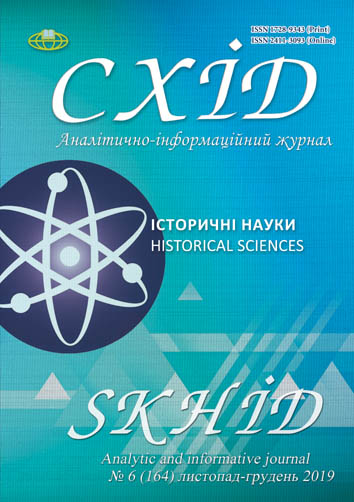“Female face” of American diplomacy
DOI:
https://doi.org/10.21847/1728-9343.2019.6(164).186918Keywords:
USA, women in diplomacy, United State Department of States, foreign affairsAbstract
The article deals with the place, role and presence of women in the United States diplomatic service in the 20th century at the beginning of the XXI century. It is noted that since the emergence of such a term as "diplomacy" in the life of America (in fact, from 1787) and until 1922, when women were given the right to vote and, as a consequence, the right to take the exam to work in the diplomatic service, no the woman did not hold even the lowest post. The only way to get involved in diplomatic relations is to be a shadow woman behind the back of a male diplomat. From 1922, women began to gradually master the basics of the diplomatic service, but met with many obstacles in their path, one of which was the reluctance of the main executive body in international relations, the State Department, to promote women in diplomatic service. To this end, potential candidates were pre-designed to "scare" situations that a woman might encounter while performing her job. However, those who eventually succeeded in the diplomatic service performed mostly clerical duties and could not speak of the possibility of occupying some senior position in the "men's club" of the diplomatic service. It was believed that the appointment of a female ambassador abroad would damage the image of the United States on the world stage. It was not until the end of World War II, when America itself set certain rules and, as a result of production necessity, did the number of women in diplomatic service begin to increase gradually every decade, reaching its climax during the reigns of Bill Clinton and Barack Obama, who, by the time the representation of women in the State Department was not lost. It was during their reign that the highest position in the US State Department was held by women. The article provides statistics on the number of female ambassadors under US presidents, ranging from F. Roosevelt to Obama.References
Arlie, Hochschild (1969). The Role of the Ambassador’s Wife: An Exploratory Study,” Journal of Marriage and the Family, p. 76.
Beatrice Loftus, McKenzie (2015). The Problem of Women in the Department: Sex and Gender Discrimination in the 1960s United States Foreign Diplomatic Service, European journal of American Studie. Retrieved from: http://journals.openedition.org/ejas/10589; DOI: 10.4000/ejas.10589 (Accessed 22 November 2019).
Beaulac, W. L. (1951). Career ambassador. Macmillan.
Calkin, H. L. (1978). Women in the Department of State: Their Role in American Foreign Affairs. Washington.
Diplomatic women: progress and shifts. Retrieved from: https://povaha.org.ua/zhinky-na-dyplomatychnyh-terenah-postup-i-zrushennya/ (Accessed 15 November 2019). (In Ukrainian).
Gender features of the diplomatic service in Ukraine and in the world (2015). Retrieved from: http://icps.com.ua/assets/uploads/images/files/s_diplomatki_b.pdf (Accessed 20 November 2019).
Hillary effect' cited for increase in female ambassadors to U.S. Retrieved from: https://www.washingtonpost.com/wp-dyn/content/article/2010/01/10/AR2010011002731.html?sid=ST2010011101598 (Accessed 25 November 2019).
Homer, Calkin (1977). Women in the Department of State: Their Role in Foreign Affairs. Retrieved from: https://files.eric.ed.gov/fulltext/ED179481.pdf (Accessed 20 November 2019).
Kabaikina, O. V., Sushchenko, O. A. (2017). Transformation of the role of women in a modern society: at family and at workplace. Moscow State University Bulletin. Series 18. Sociology and Political Science. 23(3): 140-155. (In Russian).
Klynina, T. S. (2017). On the history of the creation and functioning of the US State Department (XVIII-XX centuries.). Ukraine's international relations: scientific research and findings. Retrieved from: http://resource.history.org.ua/publ/Mzu_2017_26_16 (In Ukrainian).
Melnyk, T. M. (2004). International experience of gender transformation. Kyiv, 230 p. (In Ukrainian).
Moments in U.S. Diplomatic History. Retrieved from: http://adst.org/2014/02/whither-the-foreign-service/ (Accessed 22 November 2019).
Vagnoux, I. (2015). Introduction: North American Women in Politics and International Relations. European journal of American studies. Retrieved from: http://journals.openedition.org/ejas/10463; DOI: 10.4000/ejas.10463 (Accessed 22 November 2019).
Women in the Foreign Service. Retrieved from: https://history.state.gov/about/faq/women-in-the-foreign-service (Accessed 21 November 2019).
Wood, Molly M. (2005). Diplomatic Wives: The Politics of Domesticity and the "Social Game" in the U.S. Foreign Service, 1905-1941. Journal of Women's History, vol. 17 no. 2, pp. 142-165. Retrieved from: https://muse.jhu.edu/article/184087 (Accessed 20 November 2019).
Wood, Molly M. (2015). Wives, Clerks, and 'Lady Diplomats': The Gendered Politics of Diplomacy and Representation in the U.S. Foreign Service, 1900-1940. European journal of American studies. Retrieved from: http://journals.openedition.org/ejas/10562; DOI: 10.4000/ejas.10562. (Accessed 20 November 2019).
Yarosh, O. B. (2013). Gender equality policy: world and national experience. Kyiv, 32 p. (In Ukrainian).
Downloads
Published
How to Cite
Issue
Section
License
Copyright (c) 2019 Tetiana Klynina

This work is licensed under a Creative Commons Attribution-NonCommercial-NoDerivatives 4.0 International License.
1. Authors bear responsibility for the accuracy of facts, quotations, numbers and names used.
2. Manuscripts are not sent back.
3. The publisher does not always agree with the authors' opinion.
4. The authors reserve the right to authorship of the work and pass the first publication right of this work to the journal under the terms of a Creative Commons Attribution Non-Commercial License, which allows others to freely distribute the published research with the obligatory reference to the authors of the original work and the first publication of the work in this journal.
5. The authors have the right to conclude separate supplement agreements that relate to non-exclusive work distribution in the form in which it has been published by the journal (for example, to upload the work to the online storage of the journal or publish it as part of a monograph), provided that the reference to the first publication of the work in this journal is included.

